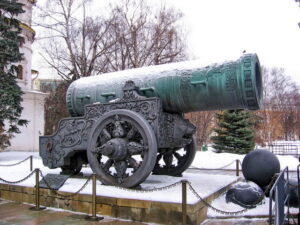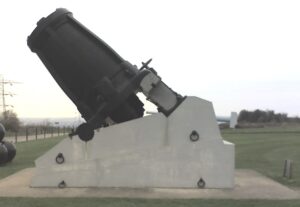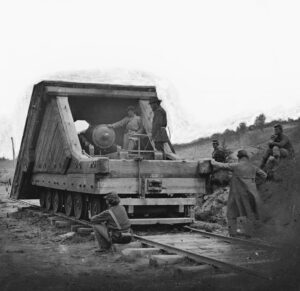Schwerer Gustav or Hitler’s giant gun was a fearsome weapon of war.
A distinctive feature of artillery of the Second World War were cannons of every increasing size and caliber. One other such weapon was the 914 mm Little David, constructed for the American army. It was intended to be used for attacking Japanese bunkers at the end of WWII. This mortar was the biggest in the world, but it was also never used in combat. The Japanese surrendered before its deployment.
Schwerer Gustav was conceived prior to the beginning of WWII when Hitler demanded its construction as a precursor to the invasion of France. It was to aid the German Army in penetrating the Maginot Line. Its construction missed the invasion of France but it did take part in some actions throughout the war. After years of development and construction, the weapon’s impact on the war was very small in the greater scheme of things. As impressive as the weapon was its fate was far from honorable.
In the following article, we will explore its precursors, conception and birth, lackluster history and ultimate fate during it’s brief, yet explosive life.
Grandfathers of the Schwerer Gustav
Enormous siege guns are nothing new to war. They have been employed in some form or other since the late middle ages. A great example would be the impressive 890mm Tsar Cannon employed by the Russians around 1586. This weapon weighs in at 39 tonnes and could fire rounds of 771 kgs. It is made of bronze and is actually a piece of art. The sheer size of the weapon itself, not to mention its ammunition rendered it somewhat useless in actual battle. It is suggested that the weapon was actually crafted more as a prestige piece than a weapon of war. This gun is currently on display outside the Kremlin along with some ornamental cannon balls.

Tsar Cannon [Image Source: Wikimedia Commons]
The Tsar cannon was not the largest caliber weapon pre 20th century, however. The British built a huge 42-tonne gun that could fire 914 mm exploding shells over 4km. This amazing weapon was called the “Mallet Mortar” and each projectile weighed in at around 1.25 tonnes. The Brits produced only two of these weapons and they were never fired in action. They were test fired of course but never used in anger.
Usage of these canons in the 20th century began with the Big Bertha (also known as the “Fat Bertha”) during World War I. Big Bertha proved its effectiveness against older fortifications by destroying several Belgian and French forts. However, these cannons were almost useless against newer constructions built of concrete reinforced with steel. This led to decreased usage of the 420 mm Big Bertha howitzers.

Mallet’s Mortar [Image Source: Wikimedia Commons]
Stay on target
The German military industry wasn’t discouraged and new grand cannons were developed despite the Big Bertha’s failure. Karl-Gerät, also called Thor (like the Viking thunder god) and Mörser Karl, were developed between 1937 and 1940. These were self-propelled siege cannons that utilized 600 mm wide barrels. They fired projectiles weighing between 1250 and 2170 kilograms. These big guns had relatively short firing ranges of “just” 10 km with the lightest shell, but it was used with varying success between 1941 and 1945.
Railway guns
Although this impressive weapon is termed a railway gun its sheer size severely restricted its movement between deployment. The gun was actually transported in sections and assembled on site. This prevented the piece from being transported assembled. The gun could be broken down into five units. These were the breech ring and block, the barrel in two pieces, the barrel jacket and cradle and trunnions. The rest of the mounting was split lengthwise for movement between battle sites. All components were transported on special flat wagons except for the bogies that could be transported on their own wheels.
True railway guns were a large artillery piece mounted on a specially designed railway wagons. The Krupp group built many such pieces for the German War effort during both world wars and smaller pieces often formed components of armored trains. In general, there is little if no need to dismantle the weapon which can be transported in whole between combat zones.
They are also not a 20th Century invention. The very first gun used in anger was utilized during the American civil war. They involved the use of a banded 32-pounder Brooke Naval Rifle mounted on a flat car and shielded with a sloping casemate. Such weapons were used during the Battle of Savage’s station. Railroad guns also had applications in the French and British Armies during the 19th century.






